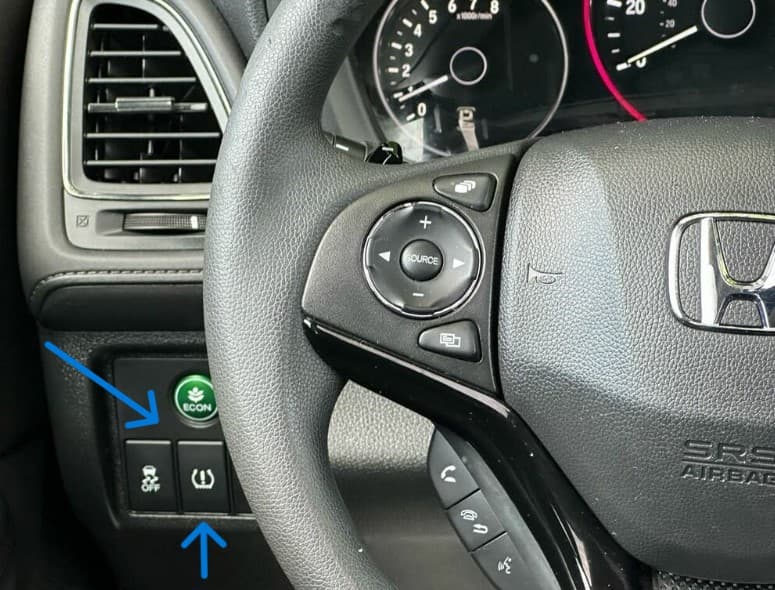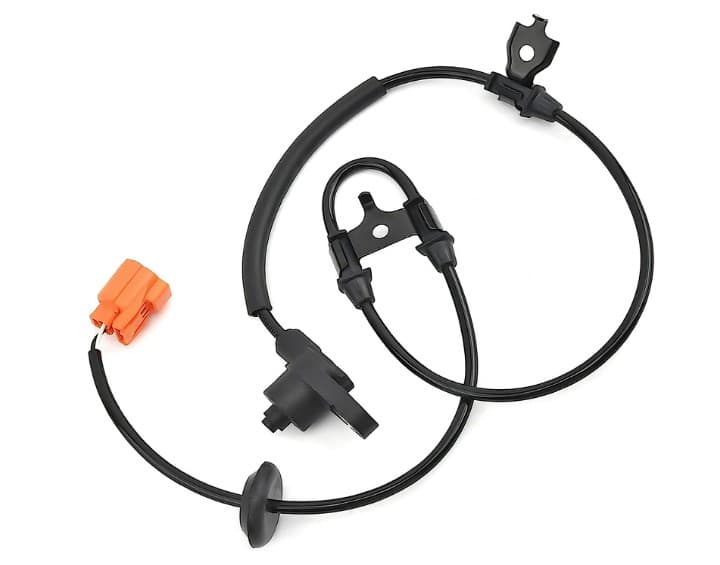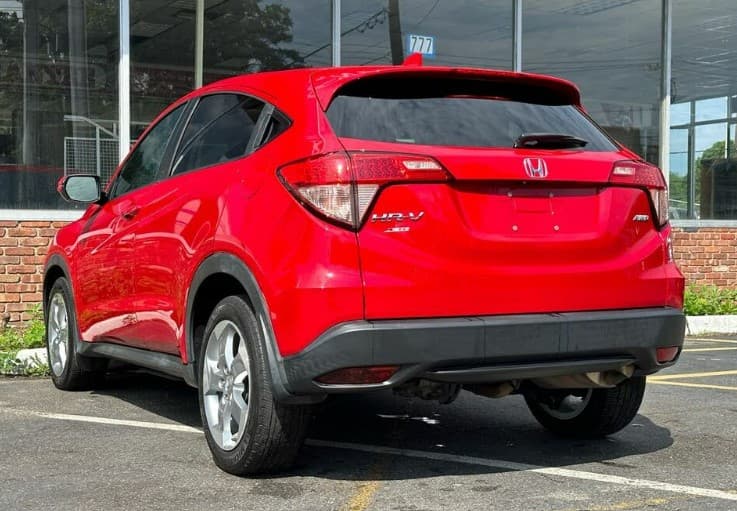How Does the 2018 Honda HR-V TPMS work?
The 2018 Honda HR-V uses an Indirect Tire Pressure Monitoring System (TPMS), which is different from the Direct TPMS found in the majority of other vehicles. Rather than using physical pressure sensors in each tire, the indirect system uses existing sensor data from the vehicle’s anti-lock braking system (ABS) to infer tire pressure. Here’s how it works:
The Role of ABS Sensors: The Indirect TPMS leverages the wheel speed data that is continuously captured by the ABS. The ABS sensors measure the rotational speed of each wheel and sends this data to the Honda computer system.
Understanding Tire Behavior: A tire that is underinflated has a slightly smaller diameter than a properly inflated one. This means an underinflated tire needs to rotate more times to cover the same distance as a properly inflated one. In essence, the underinflated tire will rotate at a higher speed.
Detecting Pressure Variations: The Indirect TPMS monitors and compares the rotational speeds of all four wheels. If the system detects that one wheel is rotating at a different speed from the others, it infers that this wheel’s tire is underinflated.
Alerting the Driver: When a significant difference in wheel rotation speeds is detected, the vehicle’s computer triggers an alert. It illuminates the TPMS warning light on the dashboard. This is represented as a yellow or orange exclamation point inside a tire cross-section.
Following Up on the Warning: If the TPMS warning light comes on, you should stop at a safe location as soon as possible and manually check the pressure in each tire with a pressure gauge and inflate any tire that is underinflated.
Calibration and Resetting: The Indirect TPMS needs to be recalibrated whenever the tires are rotated, replaced, or if the tire pressure is adjusted. In the 2018 Honda HR-V, recalibration can be initiated through the vehicle’s infotainment system. (follow the steps and video below)
Limitations: It’s important to note that the Indirect TPMS is not as precise as a Direct TPMS. It does not provide real-time pressure readings and may not trigger the warning light if all four tires lose pressure at the same rate (Remember this is highly unlikely to happen but I’m just proving a point). This is because the system works by comparing the rotational speeds of the tires and if all tires are equally underinflated their rotational speeds will still be similar. This is why manual tire pressure checks are crucial even with a TPMS.
Steps to Reset the 2018 Honda HR-v TPMS
Fill tires to the recommended pressures. (32 Psi in the front, 30 Psi in the rear)
Have the car either running or have the ignition to the ON position. (press the start button twice without your foot on the brake.)
Hold down the TPMS button. (located under the green ECON button to the left of the steering wheel.)
The tire pressure light will flash 3 times. (TPMS light located above the tachometer. It’s the yellow exclamation point)
After the TPMS light stops flashing, release the TPMS button.
Drive the Honda HR-V for a few miles at speeds over 25 Mph to complete the recalibration.
What Can Cause an Indirect TPMS Light to Turn On?
Underinflated Tire: The most common cause of the TPMS light coming on is an underinflated tire. If a tire loses pressure, due to a slow leak or sudden puncture, it will change the rotation speed of the tire, triggering the TPMS light.
Tire Damage: Any damage to the tire that could alter its shape or the way it rotates, like a bulge or bubble could potentially cause the TPMS light to come on.
Wheel Speed Sensor Malfunction: Since indirect TPMS systems rely on ABS wheel speed sensors to determine tire pressure, any issue with these sensors (like a malfunction, a dirty sensor, or a broken sensor wire or plug) could trigger the TPMS light.
Mismatched Tires: If your tires are not the same size, brand, or model, or have different tread wear, they may rotate at different speeds, causing the TPMS system to interpret this as a pressure issue.
Tire Rotation or Replacement: If you’ve just had your tires rotated or replaced, the TPMS system may need to be recalibrated. If not, it might not correctly interpret the data it’s receiving, leading to the TPMS light coming on.
Seasonal Temperature Changes: Significant changes in ambient air temperature will affect tire pressure. Generally, for every 10 degrees Fahrenheit change in temperature, tire pressure will decrease or increase by approximately 1 psi in the same direction. This means if the temperature drops from 80 to 50 degrees, your tire pressure will drop at least 3 Psi.
Worn-Out Tires: Tires that are significantly worn or unevenly worn may rotate differently which could potentially trigger the TPMS light.
System Malfunction: Finally, a problem with the TPMS system itself, such as a software glitch or system malfunction, could trigger the warning light.
When Should You Reset the 2018 Honda HR-V TPMS?
After Tire Inflation: If the TPMS light was on and you’ve inflated your tires back to the recommended pressure, you’ll need to reset the system so that it accurately monitors the newly adjusted tire pressures.
Tire Rotation: If you’ve rotated your tires, you should reset the TPMS because the tires have changed their respective positions on the vehicle. This helps the system recalibrate and monitor the tires accurately.
New Tires: When new tires are installed, resetting the TPMS is crucial. New tires can have different physical characteristics than the old ones, affecting the rotation speeds the TPMS was previously calibrated for.
After a Flat Tire Repair: After a damaged tire has been repaired (plugged or patched) and reinstalled, you should reset the TPMS.
Tire Pressure Adjustment: If you’ve changed the tire pressure for any reason, such as adjusting for off-road driving, load carrying, or track use, you’ll need to reset the TPMS after you’ve returned the tire pressure back to normal.
Change of Wheels: If you’ve changed your wheels, for instance to a different size, it may affect tire rotation speeds meaning TPMS would need to be reset to adjust to these new parameters. This also goes swapping between winter and summer tires.
Following a Battery Disconnect or Replacement: If the vehicle’s battery has been disconnected, jumped, or replaced, the TPM system may require recalibration.
Troubleshooting Issues
If there aren’t any tire leaks and you have recalibrated your Honda HR-V TPMS and the tire light will not turn off, we suggest using an OBD 2 diagnostic tool. This should not be a TPMS diagnostic tool but a standard automotive diagnostic tool. Use the diagnostic tool to find out if all the wheel speed sensors are working properly as well as checking what trouble codes the tool shows you. Steps to resolve the issue can be taken from there.
Is it Safe to Drive With the Tire Light On?
It’s essential to determine the cause of the tire light in your Honda hr-V when assessing the potential risk of driving with the light on. Is there a puncture or damage to the tire? If the tire is losing air, is it happening slowly or quickly? Could it be that the tires are fine, but a wheel speed sensor is malfunctioning or broken? While there might be circumstances where it’s acceptable to continue driving even with the tire light on, it often represents a considerable hazard. Knowing the exact nature of the problem is key to making a safe decision regarding whether and for how long you should keep driving your Honda HR-V.
Understanding tires
How to Check and Adjust Tire Pressure
Check the Recommended Pressure: Refer to your Honda HR-V’s owner’s manual or look at the sticker located on the driver’s side door jamb.
Purchase or Find a Tire Pressure Gauge: Tire pressure gauges come in different types: digital, dial, and stick. Any of these should be sufficient for checking your tire pressure.
Check the Tire Pressure: Unscrew the cap from the tire’s valve stem and press the tire pressure gauge onto the valve stem. The gauge will display the tire’s current pressure.
Compare to Recommended Levels: Compare the pressure reading with the recommended tire pressure. If it’s lower, you’ll need to add air to the tire. If it’s higher, you’ll need to let some air out.
Adjust the Pressure:
If adding air: Use an air compressor to inflate your tire. Attach the air compressor hose to the valve stem and inflate the tire in short bursts. Check the pressure frequently to avoid overinflation.
If releasing air: Press the small metal stem in the center of the valve with your finger or a tool to release air from the tire. Be careful to release air in short bursts and check the pressure frequently to avoid letting out too much air.
Recheck the Tire Pressure: Once you’ve adjusted the pressure use your tire pressure gauge to check the air pressure again. Make sure it’s at the exact recommended pressure.
Replace the Valve Cap: Once the tire pressure is at the recommended level, don’t forget to screw the valve cap back onto the valve stem. This protects the valve from dust and debris and prevents air leakage.
Repeat for All Tires: Repeat this process for each tire.
2018 Honda HR-V Tire Pressures
TIRE SIZE | FRONT PSI | REAR PSI |
215/55R17 | 32 | 30 |
SPARE | 60 | 60 |
How to Find a Tire Leak
To find a tire leak in your Honda HR-V, check all the tire pressure and determine which one is under-inflated. Pump the deflated tire up with air because spotting a leak in a flat tire can be challenging. Next, prepare a mixture of soap and water in a spray bottle (or you can use Windex) and generously spray the entire tire. Look for small bubbles emerging on the surface of the tire. If there’s a leak the escaping air will form tiny bubbles at the source of the leak. Remember: If the tire is losing air, there is a leak.
Are TPMS Legally Required?
In numerous areas such as the United States and Europe, vehicles are legally required to have a Tire Pressure Monitoring System (TPMS) . The TREAD Act, established in the U.S. in 2000 mandates that all vehicles produced after September 2007 should be equipped with a TPMS. This law mainly targets car manufacturers with the goal of improving road safety by alerting drivers to significant changes in tire pressure. Similarly, since November 2012 European regulations have necessitated that all new passenger cars include a TPMS. The purpose of these rules is to reduce the incidence of accidents caused by tire-related issues.
Emergency Tire Tools
We suggest having a set of specific tools in your Honda HR-V to handle unexpected tire incidents and emergencies.
impact gun to loosen lug nuts
19mm, 21mm or 22mm socket for lug nuts
Tire plugs and tire plug kit
Pliers
Tire pressure gauge
Extra valve caps.
Everything in this article is applicable to all Honda HR-V models and trims including the Honda HR-V LX, Sport and EX-L.
Please note that this blog post contains Amazon affiliate links. This means that if you make a purchase through one of these links, we at TPMSRESET.com may earn a small commission at no extra cost to you. We only recommend products that we personally use and believe in. Thank you for supporting us.





